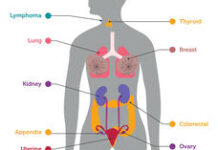The phase II APPLE is a randomised, open-label, non-comparative, multicentre, study conducted in treatment-naïve patients with common sensitising EGFR-mutated advanced non–small cell lung cancer (NSCLC). The study aim was to evaluate the feasibility of longitudinal plasma EGFR T790M monitoring and the best sequencing strategy from gefitinib to osimertinib therapy. The study previously met its primary endpoint of progression-free survival (PFS) on osimertinib at 18 months in a sequential arm.
In the updated analysis, prospective assessment of secondary endpoints demonstrates that up-front treatment with osimertinib shows a clinically meaningful lower rate of brain progression versus sequential approach, not explored clinically so far. However, comparable overall survival (OS) was observed with both treatment strategies according to Dr. Rafal Dziadziuszko of the Medical University of Gdansk in Gdansk, Poland and colleagues who published the findings on 7 February 2024 in the JCO.
The authors wrote in the background that osimertinib has been established as a standard of care for patients with common sensitising EGFR-mutated NSCLC although the sequential approach with first-generation EGFR tyrosine kinase inhibitor (TKI) gefitinib followed by osimertinib has not been formally compared.
In the EORTC LCG-163 APPLE study, patients were centrally randomly assigned into the arm A treated with osimertinib 80 mg once daily until disease progression according to RECIST v1.1, and two arms exploring the sequential approach: arm B treated with gefitinib 250 mg once daily until the emergence of molecular progression regardless of the radiologic status or at the time of disease progression by RECIST, then switching to osimertinib until a second disease progression according to RECIST and arm C treated with gefitinib until disease progression according to RECIST, then switching to osimertinib until a second radiologic disease progression.
The primary endpoint of the study was the PFS rate on osimertinib at 18 months after random assignment in arm B. Secondary endpoints included PFS, OS, and the brain PFS. Radiologic tumour assessment by body contrasted-enhanced computed tomography scan was performed every 8 weeks independent of delayed or interrupted doses. EGFR T790M monitoring was centrally performed using the Cobas EGFR Mutation Test v2.
In the first analysis, in arm B, 17% of patients switched to osimertinib based on the emergence of EGFR T790M mutation in plasma before disease progression according to RECIST, with a median time to molecular disease progression of 266 days. The study met its primary endpoint of PFS rate on osimertinib at 18 months with 67.2% (84% confidence interval [CI] 56.4 to 75.9) in arm B versus 53.5% (84% CI 42.3 to 63.5) in arm C, and a median PFS of 22.0 months versus 20.2 months.
Overall, the study team enroled 156 treatment naïve patients. Patients’ characteristics were well balanced, except for the higher proportion of baseline brain metastases in the sequential approach (29% versus 19%). Per protocol, 73% of patients switched to osimertinib in the sequential arm. Arms B and C have been pooled for the updated analyses. All the statistical analyses were performed comparing arm B/C versus arm A (sequential approach versus osimertinib up-front).
In the updated analysis, up-front treatment with osimertinib was associated with a lower risk of brain progression versus the sequential approach (hazard ratio [HR] 0.54, 90% CI 0.34 to 0.86), but a comparable OS was observed between both strategies (HR 1.01, 90% CI 0.61 to 1.68) with the 18-month survival probability of 84% and 82.3%.
At baseline, 60% of patients had detectable circulating tumour DNA (ctDNA). The clearance of ctDNA at 4 and 8 weeks after treatment initiation correlated with longer PFS regardless of the up-front treatment with osimertinib or gefitinib. By contrast, the lack of early ctDNA clearance was a marker of poor prognosis in the first-line treatment.
The authors acknowledged that the treatment landscape of EGFR-mutated NSCLC has rapidly evolved since the APPLE study was designed. Even though monotherapy with EGFR TKI is the most accepted first-line treatment strategy in EGFR-mutated advanced NSCLC, translational analysis from the APPLE and other studies such as FLAURA and AURA3 support that lack of early ctDNA clearance on EGFR TKI is a marker of poor prognosis, which may select a population of patients who could benefit from escalation treatment strategies, such as adding chemotherapy. This approach is explored in an ongoing study. Other translational analyses are ongoing in the APPLE study.
The authors concluded that the APPLE study achieved its primary endpoint and supports the longitudinal ctDNA assessment as a relevant tool for making dynamic treatment decisions. The findings related to secondary endpoints indicate that in advanced EGFR-mutated NSCLC, up-front treatment with osimertinib shows a clinically meaningful lower rate of brain progression, with no evidence of improvement in OS versus the sequential treatment approach.
The findings were previously presented at the European Lung Cancer Congress 2023 (29 March-1 April 2023, Copenhagen, Denmark).
The authors acknowledged the support of the EORTC 1613 Study team, EORTC Lung Cancer Group members, and Central Laboratory at the Medical University of Gdańsk.
Reference
Remon J, Besse B, Ponce Aix S, et al. Overall Survival From the EORTC LCG-163 APPLE Trial of Osimertinib Versus Gefitinib Followed by Osimertinib in Advanced EGFR-Mutant Non–Small-Cell Lung Cancer. JCO; Published online 7 February 2024. DOI: https://doi.org/10.1200/JCO.23.01521






